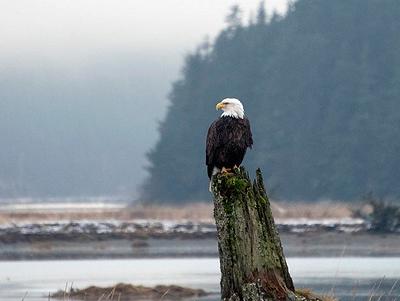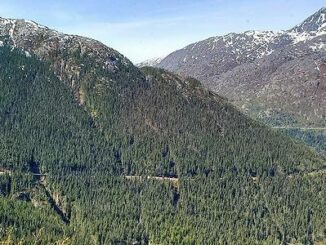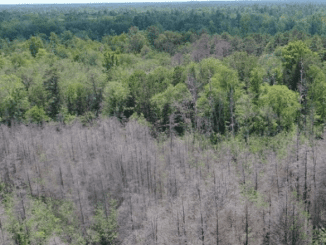
JUNEAU, Alaska, September 14, 2020 (ENS) – The Trump administration has announced plans for another timber sale that would destroy more than 5,100 acres of critical old-growth habitat in the Tongass National Forest in southeast Alaska.
At 16.7 million acres, the Tongass is the largest intact temperate rainforest left on Earth. As a globally recognized carbon sink, it helps mitigate the worst impacts of climate change and provides vital habitat for eagles, bears, wolves, salmon and numerous other species.

“Shame on the Trump administration’s Forest Service for having the gall to continue to burden and overwhelm southeast Alaskans with yet another needless and money-losing timber sale when we are in the midst of a pandemic and a controversial Alaska Roadless Rulemaking process,” said Dan Cannon, Tongass Forest program manager for Southeast Alaska Conservation Council.
An upcoming final decision on the Alaska Roadless Rule could eliminate roadless area protections and lead to new logging roads and more old-growth clearcut logging on the Tongass National Forest.
“As Alaskans await Secretary Perdue’s decision on the Roadless Rule, they will yet again have to advocate for the protection of critical old-growth habitat in their backyards,” Cannon said. “We don’t know how many times we need to say it. Timber only contributes one percent to Southeast Alaska’s economy, while the fishing and tourism industries contribute 26 percent. Stop making Southeast Alaskans’ lives more difficult by threatening our true economic drivers.”
Conservationists say the U.S. Dept. of Agriculture, USDA, has failed to pause the Alaska Roadless Rulemaking process in light of the decision by the USDA Office of Inspector General to launch an investigation into the misuse of a $2 million modified Forest Service grant given to the State of Alaska to work on the Alaska Roadless Rule.
Of that amount, roughly $150,000 has already been given to the timber industry trade group Alaska Forest Association, AFA, to provide the industry’s perspective on the Alaska-specific Roadless Rulemaking process.
While AFA was awarded this funding, the six Alaska Native Tribal governments that are federally designated cooperating agencies received zero dollars in either state or federal funding to support their participation in the Alaska Roadless Rulemaking process.
The U.S. Forest Service’s Draft Environmental Impact Statement (EIS) for the South Revilla Integrated Resource Project timber sale the agency is proposing a multi-year project involving a variety of timber harvest, road construction, watershed restoration and recreation activities.
The Forest Services proposes chainsawing 5,115 acres of old-growth forest near Ketchikan. It also would allow bulldozing or rebuilding more than 80 miles of logging roads costing U.S. taxpayers more than $11 million.
The public comment period is still open. Members of the public can comment on the Tongas National Forest South Revilla logging project here. Comments are requested by 10/19/2020.

“This assault on America’s largest rainforest will destroy important habitat for salmon, bears and wolves, and worsen the climate crisis,” said Randi Spivak, public lands director at the Center for Biological Diversity. “Clearcutting the Tongass and wiping out enormous carbon stores is like cutting off part of the planet’s oxygen supply.”
“It’s mind-boggling that the Trump administration wants to decimate this spectacular old-growth forest and erase one of the solutions to averting catastrophic climate change,” Spivak mourned.
This project and the proposed elimination of the Roadless Area Conservation Rule on the Tongass are part of the Trump administration’s relentless efforts to clearcut large swaths of remaining old-growth across the national forests, consistent with the administration’s policy of increasing logging nationwide.
“As forests across the Americas burn, the last thing we need to do is destroy old-growth forests in the Tongass Rainforest – one of the United States’ best defenses against furthering the climate crisis,” said Osprey Oreille Lake, executive director for the Women’s Earth and Climate Action Network, WECAN. “Existing within the territories of the Tlingit, Haida, and Tsmishian peoples, the Tongass is a vital ecosystem necessary to the traditional life-ways of local Indigenous communities,” she said.
“Destroying critical old-growth in the Tongass, not only devastates wildlife habitat and harms the climate, but disregards the sovereignty of Indigenous peoples and further perpetuates modern genocidal policies,” Lake said. “We must stand together for our forests, communities and the climate.”
The roughly 17 million-acre Tongass is the largest national forest in the United States. Alaska Native people rely on the area for culture, traditional hunting, fishing and livelihoods. People from around the world visit the Tongass for world-class recreation, sport and commercial fishing.
“It was just over two months ago that a federal judge threw out the largest logging project we’ve seen in decades because the Forest Service failed to provide communities with basic information like where it intended to log,” said Olivia Glasscock, an attorney at Earthjustice. “Nevertheless the agency is back again with another massive timber sale targeting irreplaceable old-growth trees in the same cherished national forest.”
“Urgent action is needed to address the climate crisis, and that includes efforts to preserve the magnificent trees that absorb carbon,” Glasscock said. “Unfortunately, this destructive logging plan will only make the problem worse.”
“Alaska Rainforest Defenders asked, plain and simple in our September 2018 scoping comments on the South Revilla project, that the Forest Service drop the timber part of the project,” said spokesman Larry Edwards. “Environmentalists have no complaints over the non-timber components of this project.”
“In the DEIS, all of the alternatives for the project are estimated to have a timber sale value appraised at a loss to taxpayers, which means that legally a timber sale could not be offered. Continuing to a final EIS would be gambling with millions of dollars of Forest Service planning effort at taxpayer expense,” Edwards said.
Logging the Tongass has been tremendously costly for taxpayers. A new report estimates that timber sales from the forest have cost taxpayers $1.7 billion over four decades.
“Despite a commitment to move away from unsustainable old-growth timber sales, the U.S. Forest Service continues to offer these sales in the Tongass National Forest. More clearcutting will damage the real drivers of southeast Alaska’s economy: fish, wildlife and tourism. Defenders won’t stand by and watch as the Forest Service despoils irreplaceable wildlife habitat and threatens sustainable jobs and livelihoods in Southeast Alaska,” said Nicole Whittington-Evans, Alaska Program Director for Defenders of Wildlife.
Members of the public can comment on the Tongas National Forest South Revilla logging project here. Comments are requested by 10/19/2020.
Copyright Environment News Service (ENS) 2020. All rights reserved.
© 2020, Environment News Service. All rights reserved. Content may be quoted only with proper attribution and a direct link to the original article. Full reproduction is prohibited.



